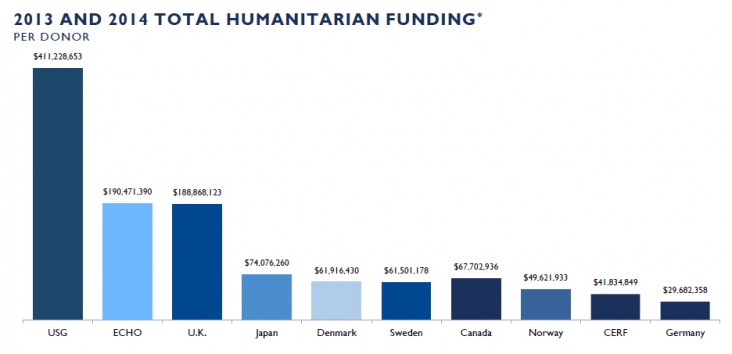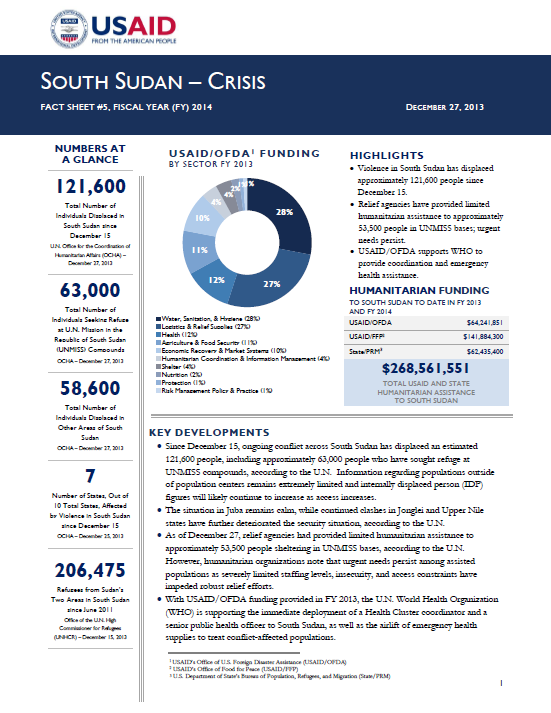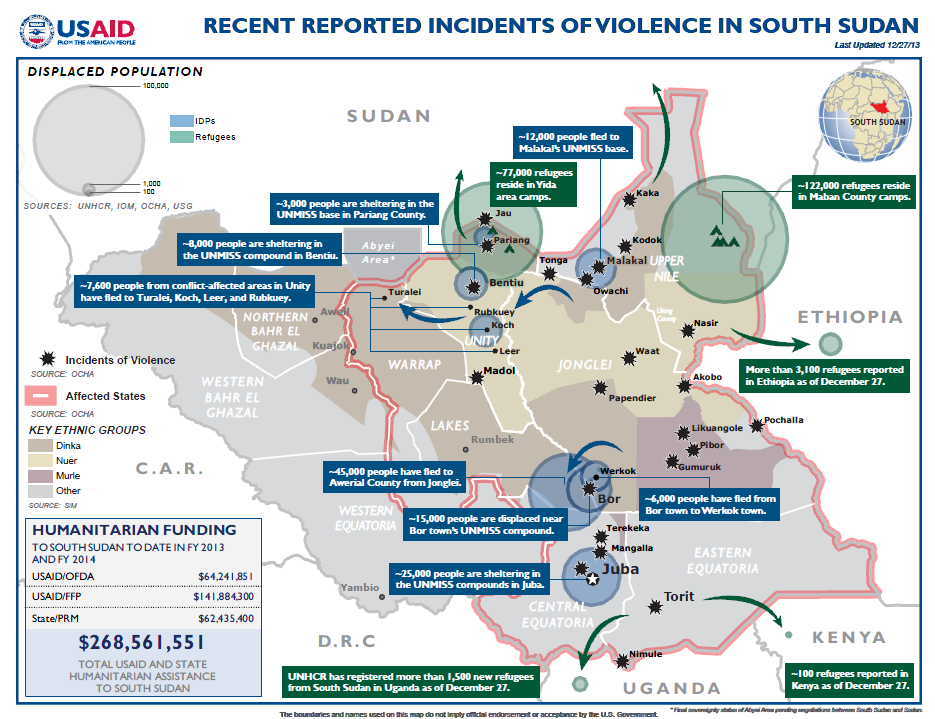- What We Do
- Agriculture and Food Security
- Democracy, Human Rights and Governance
- Economic Growth and Trade
- Education
- Environment and Global Climate Change
- Gender Equality and Women's Empowerment
- Global Health
- Humanitarian Assistance
- Transformation at USAID
- Water and Sanitation
- Working in Crises and Conflict
- U.S. Global Development Lab
Speeches Shim
May 2, 2014
Numbers At A Glance
923,000
78,300
844,700
300,800
237,700
Humanitarian Funding:
To South Sudan To Date In FY2014:
| USAID/OFDA | $60,775,086 |
| USAID/FFP | $35,000,000 |
| State/PRMDoD | $47,300,000 |
| TOTAL | $143,075,086 |
Highlights
High-level U.S. Government (USG) and U.N. personnel condemn violence; warn of famine in South Sudan.
Insecurity continues to impede humanitarian response efforts.
Tensions remain high in Bentiu town, Unity State, and Bor town, Jonglei State, following mid-April violence.
KEY DEVELOPMENTS
U.S. Secretary of State John F. Kerry traveled to South Sudan on May 2 to meet with President Salva Kiir to encourage implementation of the January 23 ceasefire agreement and urge the deployment of an additional 2,500 African peacekeeping troops to South Sudan. Secretary Kerry condemned the violence—particularly targeted killings based on ethnicity—and drew attention to the growing risk of increased ethnic tension and famine in the country.
U.N. High Commissioner for Human Rights Navi Pillay and U.N. Special Adviser for the Prevention of Genocide Adama Dieng traveled to South Sudan to meet with senior Government of the Republic of South Sudan (RSS) officials during the week of April 28. High Commissioner Pillay criticized President Kiir and former Vice President Riek Machar for their apparent lack of concern regarding the threat of famine.
Tensions remain high in Bor, Duk, and Twic East counties, Jonglei; Rubkona County, Unity; and Renk County, Upper Nile, according to the U.N. In addition, fighting erupted between Sudan People’s Liberation Army (SPLA) elements in Wau town, Western Bahr el Ghazal State, on April 26, prompting more than 800 people to flee to the UNMISS base in Wau.
Relief organizations continue to respond to the needs of more than 22,500 people sheltering at the UNMISS base in Bentiu. The internally displaced persons (IDPs) fled to the base following mid-April violence, which targeted civilians based on ethnicity and nationality.
INSECURITY, DISPLACEMENT, AND ACCESS CONSTRAINTS
The current conflict in South Sudan, particularly in Jonglei, Unity, and Upper Nile, has displaced more than 1.2 million people—including 923,000 IDPs and 300,800 people who are seeking refuge in neighboring countries—since December 15.
On April 23, clashes erupted in Renk County, Upper Nile, resulting in additional population displacement. Reports suggest approximately 30,000 to 40,000 people are fleeing conflict-affected areas in Renk toward Melut County, Upper Nile, according to the U.N.
Hostilities between SPLA elements in Wau on April 26 forced at least 800 people to seek shelter at the civilian protection area at the UNMISS compound, according to the International Organization for Migration (IOM).
Tensions are high in Duk and Twic East counties, where fighting in late April prompted civilians to flee across the White Nile River toward Mingkaman town, Awerial County, Lakes State. Tensions also remain high in Bor and Bentiu, where mid-April violence resulted in civilian casualties.
South Sudan Crisis Fact Sheet #40 May 2, 2014 ![]() (pdf - 260k)
(pdf - 260k)
South Sudan Crisis Map May 2, 2014 ![]() (pdf - 956k)
(pdf - 956k)
HUMANITARIAN NEEDS ASSESSMENTS AND RESPONSE ACTIVITIES
The South Sudan IPC analysis workshop—comprising participants from the RSS, USAID’s Famine Early Warning Systems Network (FEWS NET), the U.N. Food and Agriculture Organization (FAO), the U.N. World Food Program (WFP), and other partner organizations—began in Yei County, Central Equatoria State, on April 24 to evaluate food security conditions in South Sudan.[1] The analysis, which partners will likely release in mid-May, will integrate data from emergency food security assessments conducted by FAO, WFP, and several non-governmental organizations (NGOs).
As of April 28, the U.N. Rapid Response Mechanism—led by the U.N. Children’s Fund (UNICEF), FAO, and WFP—had provided humanitarian assistance, including more than 90 metric tons (MT) of relief commodities, in nine remote locations. In Jonglei, rapid response teams screened 1,540 children for malnutrition in Pochalla town and more than 570 children and pregnant and lactating women in Lankien town during the week of April 21. Relief actors provided children in both locations with health care services, including measles vaccinations and deworming tablets.
CAMP COORDINATION AND CAMP MANAGEMENT
The Camp Coordination and Camp Management Cluster—the coordinating body for humanitarian camp coordination and management activities, comprising U.N. agencies, NGOs, and other stakeholders—continues efforts to improve and expand existing civilian protection areas at UNMISS bases across the country. Despite progress, ongoing fighting and resultant insecurity, as well as funding constraints and logistical challenges, are hindering construction progress.
AGRICULTURE, FOOD SECURITY, AND NUTRITION
U.N. Resident and Humanitarian Coordinator (RC/HC) Toby Lanzer released a statement on April 29 calling on parties to the conflict to “observe one month of tranquility” during May to enable civilians to move freely within the country and plant crops before the April-to-May planting season ends. RC/HC Lanzer noted that civilians need to plant and cultivate to ensure a harvest at the end of 2014.
Food Security and Livelihoods Cluster partners continue to provide food commodities to vulnerable populations across South Sudan to stem growing food insecurity. As of April 24, USAID/FFP partner WFP and implementing partners had provided approximately 1.2 million people—including IDPs, other conflict-affected people, refugees within South Sudan, and displaced people not directly affected by the current crisis—with food assistance.
To increase food security in Eastern Equatoria State’s Torit County, where some families are hosting people displaced by the conflict, relief agencies provided crop kits—including cowpea, maize, and sorghum—to nearly 10,300 families, vegetable kits to approximately 9,300 families, and fishing kits to more than 2,000 families, according to the U.N.
Meanwhile, WFP continues to facilitate food commodity airdrops in conflict-affected areas of Jonglei, Unity, and Upper Nile. WFP mobile distribution teams, which quickly register populations in target areas and retrieve and distribute airdropped food commodities, are currently operating in Lankien, Moto, Pibor, and Pochalla towns, Jonglei; Ganyel town, Unity; and Ulang town, Upper Nile.
UNICEF provided 385 cartons of Plumpy’Nut—a specialized nutrition product—to the international NGO CARE for distribution at the Bentiu UNMISS compound, where approximately 22,500 IDPs are currently sheltering. In late April, UNICEF and partners in Bentiu screened 405 children under five years of age for malnutrition, finding 6.2 percent severe acute malnutrition and 60 percent moderate acute malnutrition. Between April 22 and 28, nutrition actors screened nearly 3,900 children for malnutrition across South Sudan using the mid-upper arm circumference assessment technique.
HEALTH AND WASH
As congestion at the UNMISS civilian protection areas continues to contribute to poor health and water, sanitation, and hygiene (WASH) conditions, relief actors are urgently working to deliver critical assistance to IDPs. UNICEF and partners recently constructed a borehole for the IDPs sheltering at the UNMISS civilian protection site in Bentiu, increasing IDP access to safe drinking water from 2 liters per person per day to 6.5 liters per person per day. In addition, WASH partners constructed several new latrines in the protection area, improving the people-to-latrine ratio from one-to-317 to one-to-129, according to UNICEF.
In Bor, NGO International Aid Services continues to supply safe drinking water to approximately 5,000 IDPs sheltering in the UNMISS civilian protection area. Relief agencies are also providing WASH commodities, such as soap; conducting hygiene promotion activities; and managing solid and liquid waste.
As of May 1, relief organizations had provided health care assistance to more than 1 million people across South Sudan, according to the Health Cluster. Immunization campaigns are ongoing, with more than 248,000 children vaccinated against measles, 159,700 children vaccinated against polio, and more than 74,000 people vaccinated against cholera since December 2013.
Insecurity continues to impact health conditions countrywide, with displacement and resultant congestion at IDPs sites increasing public health risks. According to the Health Cluster, acute respiratory infection, acute watery diarrhea, and malaria remain the three most commonly reported health concerns in South Sudan’s IDP sites.
LOGISTICS AND RELIEF COMMODITIES
The Logistics Cluster continues to facilitate the delivery and distribution of relief commodities to conflict-affected populations across the country. In the coming days, the Logistics Cluster plans to deploy additional mobile storage units to Bor and Malakal to increase storage capacity.
The Logistics Cluster reports that armed elements continue to hinder the transportation of relief commodities via road, with one NGO recently having to stop at nearly 30 checkpoints while traveling between Rumbek town, Lakes, and Juba. In addition, fighting has delayed the transportation of food commodities to refugees in Upper Nile’s Maban County, preventing WFP from conducting critical food distribution activities. As a result, WFP and implementing partners distributed reduced food commodity rations during March and April. According to UNHCR, refugees are resorting to negative coping mechanisms, such as selling non-food relief items. Malnutrition levels among refugee children in the Maban camps are nearing the U.N. World Health Organization (WHO) emergency threshold level of 15 percent.
PROTECTION
As of April 29, relief organizations had reached nearly 25,900 children with child protection services, according to UNICEF. Child protection actors continue to provide psychosocial support to approximately 6,900 children at 16 child-friendly spaces in Bor; Juba; Mingkaman; Melut; and Nyal town, Unity.
As of April 28, relief actors had reunified nearly 270 children—of the approximately 3,500 children identified as unaccompanied, separated, or missing since December 15—with parents or family members, UNICEF reports.
To investigate recent violence targeting civilians, U.N. High Commissioner Pillay and U.N. Special Adviser Dieng traveled to South Sudan on April 28. The high-level U.N. delegation met with senior government officials, including President Salva Kiir, and plan to investigate recent killings targeting civilians in Bentiu on behalf of U.N. Secretary-General Ban Ki-Moon.
OTHER HUMANITARIAN ASSISTANCE
To date, international donors have provided approximately $497 million—more than 39 percent of the $1.27 billion total requested funding—to support humanitarian activities through the South Sudan Crisis Response Plan. Of the $773 million shortfall in funding, humanitarian partners have reported that a minimum of $232 million is necessary to maintain current service levels and prevent a severe deterioration of humanitarian conditions in the next three months, according to the U.N.

*Funding figures are as of April 25, 2014. All international figures are according to OCHA’s Financial Tracking Service (FTS) and based on international commitments during the 2013 and 2014 calendar years. USG figures are according to the USG and reflect the most recent USG commitments based on the 2013 fiscal year, which began on October 1, 2012, and ended September 30, 2013, as well as the 2014 fiscal year, which began on October 1, 2013.



Comment
Make a general inquiry or suggest an improvement.